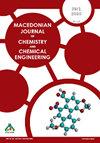Мultivariate analysis for rapid screening and prediction of solid-state compatibility in pharmaceutical preformulation studies-paving the road for machine learning
IF 1.1
4区 化学
Q3 CHEMISTRY, MULTIDISCIPLINARY
Macedonian Journal of Chemistry and Chemical Engineering
Pub Date : 2024-05-19
DOI:10.20450/mjcce.2024.2838
引用次数: 0
Abstract
Multivariate analysis models were developed to evaluate the results obtained from a compatibility study designed for ibuprofen with a large group of different types of excipients, as a possible approach for rapid screening of the incompatibility between the active pharmaceutical ingredient (API) and excipients. The solid-state characterization of the binary mixtures was performed by Fourier transform infrared spectroscopy (FTIR) and differential scanning calorimetry (DSC). Principal component analysis (PCA) and partial least squares-discriminant analysis (PLS-DA) using SIMCA® software were applied for evaluation of the experimentally obtained results. The optimal PCA model for the FTIR spectra explains 96.2 % of the variations in the dataset with good statistical indicators (R2X = 0.960, Q2 = 0.900), which was also the case for the PCA model for the DSC curves (R2X = 0.981, Q2 = 0.866). The applied PLS-DA models have shown similar behaviour to the PCA. Moreover, the main spectral variations in the FTIR spectra and the thermal events in the DSC data were attributed the highest variable importance for the projection (VIP) scores in the corresponding VIP plots, confirming the model capability for predicting ibuprofen interactions. Furthermore, the prediction power of the optimal models for FTIR and DSC experimental data was evaluated by the root mean square error of prediction (RMSEP) of 0.10 and 0.16, respectively. The obtained results demonstrated the potential of multivariate statistical analysis as a machine learning-based technique for screening and prediction of ibuprofen-excipients solid-state compatibility in the preformulation phase of the pharmaceutical development of dosage forms.用于快速筛选和预测药物制剂前研究中固体相容性的多变量分析--为机器学习铺平道路
开发了多变量分析模型来评估布洛芬与大量不同类型辅料的相容性研究结果,以此作为快速筛查活性药物成分(API)与辅料之间不相容性的一种可能方法。傅立叶变换红外光谱法(FTIR)和差示扫描量热法(DSC)对二元混合物进行了固态表征。使用 SIMCA® 软件进行了主成分分析(PCA)和偏最小二乘判别分析(PLS-DA),以评估实验结果。傅立叶变换红外光谱的最佳 PCA 模型解释了数据集中 96.2% 的变化,统计指标良好(R2X = 0.960,Q2 = 0.900),DSC 曲线的 PCA 模型也是如此(R2X = 0.981,Q2 = 0.866)。应用的 PLS-DA 模型显示出与 PCA 相似的行为。此外,在相应的 VIP 图中,傅立叶变换红外光谱中的主要光谱变化和 DSC 数据中的热事件对预测(VIP)得分的变量重要性最高,这证实了该模型预测布洛芬相互作用的能力。此外,预测的均方根误差(RMSEP)分别为 0.10 和 0.16,从而评估了最佳模型对傅立叶变换红外光谱和 DSC 实验数据的预测能力。所获得的结果证明了多元统计分析作为一种基于机器学习的技术在筛选和预测布洛芬-辅料固态相容性方面的潜力,该技术适用于剂型药物开发的制剂前阶段。
本文章由计算机程序翻译,如有差异,请以英文原文为准。
求助全文
约1分钟内获得全文
求助全文
来源期刊
CiteScore
1.60
自引率
20.00%
发文量
14
审稿时长
>12 weeks
期刊介绍:
Macedonian Journal of Chemistry and Chemical Engineering (Maced. J. Chem. Chem. Eng.) is an official publication of the Society of Chemists and Technologists of Macedonia. It is a not-for-profit open acess journal published twice a year. The journal publishes original scientific papers, short communications, reviews and educational papers from all fields of chemistry, chemical engineering, food technology, biotechnology and material sciences, metallurgy and related fields. The papers published in the Journal are summarized in Chemical Abstracts.

 求助内容:
求助内容: 应助结果提醒方式:
应助结果提醒方式:


